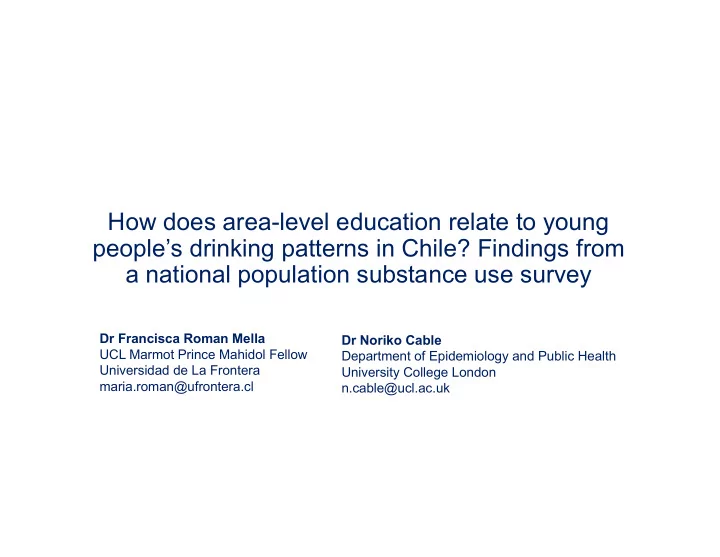

How does area-level education relate to young people’s drinking patterns in Chile? Findings from a national population substance use survey Dr Francisca Roman Mella Dr Noriko Cable UCL Marmot Prince Mahidol Fellow Department of Epidemiology and Public Health Universidad de La Frontera University College London maria.roman@ufrontera.cl n.cable@ucl.ac.uk
Young people’s alcohol use in Chile Percentage of deaths attributable to alcohol use by age and gender Identification of upstream factors: Source: Castillo-Carniglia, Á., Kaufman, J. S., & Pino, P. (2013). Interventions at area level could widely Young people aged 15 to 24 benefit young people and involve reported the heaviest amount of multiple social actors in reducing alcohol alcohol consumed on a typical use and harm 3 occasion (80 gr of pure alcohol) 2
Chile Economic growth, income inequality and socioeconomic segregation School and residential socioeconomic segregation 4,5 Uneven distribution of disadvantaged people across municipalities Social exclusion of disadvantaged groups 6
Hypotheses Among young people aged 18 to 25 • Drinking (vs. non-drinking) and frequent drinking (vs. infrequent) are positively associated with area-level education • Heavy episodic drinking (once or more vs. never) is negatively associated with area-level education
Individual-level data National General Population Substance Use Survey • Aims to determine the magnitude and trends of substance use and Objective the associated risk/protective factors Representative •Nationally representative sample Age •General population aged 12 to 64 • Complex survey design: multi-stage stratified cluster sampling Sampling design • Municipalities, census tracts and households Sample size • 2014:19,512 2016: 19,147
Alcohol use measures Am Among those reporting past-ye year alcohol use Heavy episodic Frequency of Drinker status drinking drinking Drinking vs. non-drinking Frequent vs. infrequent Once or more vs. never Have you ever consumed How often do you drink How often have you consumed alcohol (beer, wine or spirits)? alcohol? 6 or more drinks on a single occasion? Response options: yes/no Infrequent : never / once a month or less Never Frequent : 2 to 4 times a Once or more : less than once month/ 2 to 3 times a week / 4 a month, monthly, weekly and or more times a week daily
Area-level education Distribution of surveyed municipalities according to the percentage of adults aged 25 and over with higher • Area-level education was education measured as the percentage of adults aged 25 and over with higher education in each municipality (district). • Information was extracted from the National Census 2017 • Range: 11.3% – 79% Municipalities=108
Analytical plan Pooled data: N=5,847 Multilevel modelling • Complete cases analysis • Hierarchical structure of data • Drinker status: N=5,537, 95% • I ndividuals nested within municipalities • Frequency of drinking and Heavy episodic drinking: N= 3,763, 96% Multilevel logistic regression Adjustment approach • Drinker status: drinking vs. • Employment status, marital non-drinking status, head of household’s education, self-rated health, • Frequency of drinking: gender, age, survey year frequent vs. infrequent • Heavy episodic drinking: once or more vs. never
IQOR 95% CI Drinker status Area-level education 1.25 1.03,1.54 OR 95% CI Drinking vs. non-drinking Self-rated health 0.99 0.91,1.08 N=5,537 Marital status Single (ref) Married/cohabiting 1.08 0.89,1.32 Separated 0.65 0.36,1.17 Head of household’s education Primary (ref) Secondary 1.13 0.94,1.36 Tertiary 1.59 1.27,1.99 Economic activity In employment (ref) Not in employment 0.75 0.63,0.88 Age 1.07 1.03,1.11 Women (vs. men) 0.71 0.61,0.83
IQOR 95% CI Frequency of drinking Area-level education 1.20 1.08,1.33 OR 95% CI Frequent vs. infrequent Self-rated health 0.99 0.91,1.02 N=3,763 Marital status Single (ref) Married/cohabiting 0.68 0.57,0.80 Separated 0.48 0.23,0.97 Head of household’s education Primary (ref) Secondary 0.91 0.76,1.09 Tertiary 1.40 1.14,1.70 Economic activity In employment (ref) Not in employment 0.79 0.68,0.91 Age 1.05 1.01,1.08 Women (vs. men) 0.55 0.48,0.63
IQOR 95% CI Heavy episodic drinking Area-level education 1.14 1.01,1.27 OR 95% CI Once or more vs. never Self-rated health 1.01 1.001,1.01 N=3,763 Marital status Single (ref) Married/cohabiting 0.72 0.59,0.87 Separated 0.66 0.31,1.41 Head of household’s education Primary (ref) Secondary 0.99 0.82,1.20 Tertiary 0.78 0.78,1.20 Economic activity Employed (ref) Non-employed 0.87 0.74,1.01 Age 1.02 0.98,1.05 Women (vs. men) 0.38 0.33,0.44
Conclusions Frequent drinking was socioeconomically patterned at area level • Socially advantaged areas: purchasing power and greater availability of social drinking settings 7 Area-level education seems to be unrelated to being a drinker and heavy episodic drinking among young people • Significant variation between municipalities in drinker status • Lack of association might also relate to the definition of the area 8
References 1. Castillo-Carniglia Á, Kaufman JS, Pino P. Alcohol-Attributable Mortality and Years of Potential Life Lost in Chile in 2009. Alcohol Alcohol. 2013;48(6):729-36. 2. Margozzini P, Sapag JC. El consumo riesgoso de alcohol en Chile: tareas pendientes y oportunidades para las políticas públicas [Harmful drinking in Chile: tasks and oppotunities for public policy]. Temas de la Agenda Publica. 2015;10(75):1-15. 3. Jackson N, Denny S, Ameratunga S. Social and socio-demographic neighborhood effects on adolescent alcohol use: A systematic review of multi-level studies. Soc Sci Med. 2014;115:10-20. 4. Organisation for Economic Co-operation and Development. (2012). OECD Economic Survey: Chile 2012 OECD Economic survey: OECD Publishing. 5. Larrañaga, O., & Sanhueza, C. (2007). Residential segregation effects on Poor's opportunities in Chile. Santiago, Chile: Departamento de Economia, Universidad de Chile. 6. Valenzuela, J. P., Bellei, C., & De Los Ríos, D. (2010). Segregación Escolar en Chile. In S. Martinic & G. Elacqua (Eds.), ¿ Fin del ciclo? Cambios en la gobernanza del sistema educativo (pp. 209-229). Santiago de Chile: UNESCO and Pontifica Universidad Católica de Chile. 7. Karriker-Jaffe KJ. Areas of disadvantage: a systematic review of effects of area-level socioeconomic status on substance use outcomes. Drug Alcohol Rev. 2011;30(1):84-95. 8. Diez Roux AV, Mair C. Neighborhoods and health. Ann N Y Acad Sci. 2010;1186:125-45.
Thanks
Recommend
More recommend